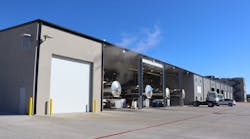Construction spending dropped for the second consecutive month in September as declines in public and private nonresidential construction, as well as multifamily projects, offset growth in single-family homebuilding, according to an analysis by the Associated General Contractors of America. Association officials said the new spending figures underscore how challenging current market conditions are for many firms.
“These data show that construction gains remain fragmentary and volatile, even though industry employment has been picking up in more states,” said Ken Simonson, the association's chief economist. “Many categories of spending rose sharply over the past year but month-to-month changes have been mixed.”
Construction spending in September totaled $951 billion at a seasonally adjusted annual rate, down 0.4% from the August total but 2.9% higher than in September 2013, Simonson noted. Private residential spending edged up 0.4% from August and 0.7% from a year earlier, while private nonresidential spending dropped 0.6% for the month but rose 6.3% year-over-year. The third component of the total—public sector construction spending—decreased 1.3% from August but increased 1.7% from a year ago.
The divergent patterns appeared through all sectors, Simonson said. Single-family home construction gained 1.1% for the month and 9.8% over 12 months, while multifamily spending fell 1.0% from the August level but jumped 26% from a year earlier. The largest private nonresidential type, power construction—which includes oil and gas fields and pipelines as well as electric power—slumped 3.1% in September but rose 2.3% from the prior year.
Commercial construction—comprising retail, warehouse and farm projects—increased 1.4% and 13%, respectively. Manufacturing construction decreased 1.1% for the month but leaped 17% year-over-year. Among the largest public segments, highway and street construction declined 3.7% and 1.7%, respectively, while public educational construction inched up 0.1% from August and 8.4% from September 2013.
Association officials said the monthly declines in construction spending added new challenges to an industry struggling to recover from a years-long downturn and coping with growing labor shortages amid demographic and economic shifts. They said Washington DC officials could help by enacting long-term infrastructure measures and taking steps to make it easier for schools, associations, and businesses to prepare future construction workers.








